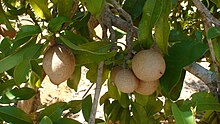So I've only sort of been cooking. Still trying to get things out of boxes and find myself. I don't love my new kitchen. I'm not very excited about spending much time in my kitchen. I hope things will change over time, but I haven't been as excited about trying out new recipes here. Still trying to figure out the shopping thing, and find my stuff. Hopefully it will come.
I am however, VERY excited about finding Sapotes in the grocery store.
Okay - I guess I lied. I went to the grocery store today with my kids for the first time to do some real shopping other than the bananas, grapes, broccoli, milk, bread, eggs, cheese type of shopping.
The produce section was CHOCK FULL of funky stuff I'd never seen before. We are going to go back, write down the names of the funky stuff, figure out what it is, and how to cook it, and we are going to try some new stuff. I guess I am sort of excited...it is just taking some time.
When we walked into the produce section, I instantly recognized one of my favorite fruits from Guatemala. We called them sapotes. In the Caribbean they are called sapodillas, and they are called both here in Florida. Actually they were listed here as a mamey sapote. My friends from Mexico who live here called it a mamey (not like mommy, but like ma'am A)
Here's a description:
The fruit is a large ellipsoid berry, 4–8 cm in diameter, very much resembling a smooth-skinned potato and containing two to five seeds. Inside, its flesh ranges from a pale yellow to an earthy brown color with a grainy texture akin to that of a well-ripened pear. The seeds are black and resemble beans, with a hook at one end that can catch in the throat if swallowed. The fruit has a high latex content and does not ripen until picked, whereupon the fruit softens to a firmness and appearance very similar to that of a fuzzy, brown-skinned kiwifruit.
The fruit has an exceptionally sweet, malty flavor. Many believe the flavor bears a striking resemblance to caramel or a pear candied with brown sugar. The unripe fruit is hard to the touch and contains high amounts of saponin, which has astringent properties similar to tannin, drying out the mouth.
I used to eat these for dinner every night - oh so delectable. Mine is sitting on my counter ripening as we speak! I'll spend some time and see what cool recipes we can come up with for these babies. Can't wait.


No comments:
Post a Comment